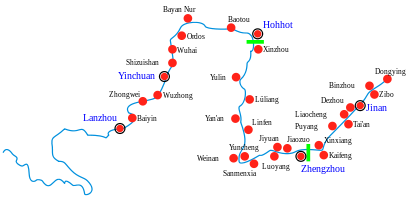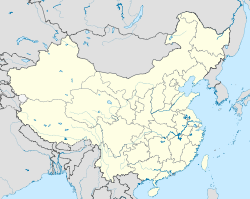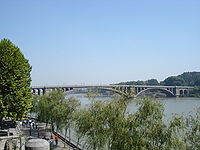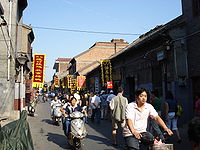- Luoyang
-
"Loyang" redirects here. For the industrial estate in Singapore, see Loyang, Singapore.
Luoyang
洛阳— Prefecture-level city — 洛阳市 Luoyang in Henan Location in China Coordinates: 34°40′11″N 112°26′32″E / 34.66972°N 112.44222°ECoordinates: 34°40′11″N 112°26′32″E / 34.66972°N 112.44222°E Country People's Republic of China Province Henan Government - Mayor Guo Hongchang Area - Prefecture-level city 15,492 km2 (5,981.5 sq mi) - Urban 4,304 km2 (1,661.8 sq mi) Elevation 144 m (472 ft) Population (2010 census) - Prefecture-level city 6,549,486 - Density 422.8/km2 (1,095/sq mi) - Urban 1,500,000 - Urban density 348.5/km2 (902.6/sq mi) Time zone China Standard (UTC+8) Area code(s) 379 GDP ¥30,080 per capita (2008) Ethnicities Han, Hui, Manchu, Mongolian County-level divisions 15 Township-level divisions unknown License plate prefixes 豫C Website http://www.ly.gov.cn Luoyang (simplified Chinese: 洛阳; traditional Chinese: 洛陽; pinyin: Luòyáng; Postal map spelling: Loyang; IPA: [lwɔ̂jɑ̌ŋ]) is a prefecture-level city in western Henan province of Central China. It borders the provincial capital of Zhengzhou to the east, Pingdingshan to the southeast, Nanyang to the south, Sanmenxia to the west, Jiyuan to the north, and Jiaozuo to the northeast.
Situated on the central plain of China, one of the cradles of the Chinese civilization, Luoyang was one of the Four Great Ancient Capitals of China.
Contents
Names
The origin of the name "Luoyang" is the city's location to the north side ("yang") of the Luo River. The river flows from west to east and the sun is on south of the river, so that the sun shine is always on north side of the river. Luoyang has had several names over the centuries, including "Luoyi" (洛邑) and "Luozhou (洛州)", though Luoyang has been its primary name. It has been called, during various periods, "Dongdu" (东都, meaning the Eastern Capital, during the Tang Dynasty), "Xijing" (西京, meaning the West Capital, during the Song Dynasty), or "Jingluo" (京洛, meaning the general capital for China).
History
 White Horse Temple gate
White Horse Temple gate
The greater Luoyang area has been sacred ground since the late Neolithic period. This area at the intersection of the Luo and Yi rivers was considered to be the geographical center of China. Because of this sacred aspect several cities, all of which are generally referred to as "Luoyang", have been built there. In 2070 BCE, the Xia Dynasty king Tai Kang moved the Xia capital to the intersection of Luo river and Yi River and named the city Zhenxun (Chinese: 斟鄩; pinyin: Zhēnxún). In c 1600 BCE, King Tang of Shang defeated Jie, the final Xia Dynasty king, and built Western Bo (Chinese: 西亳; pinyin: Xībó), a new capital on the Luo River. The ruins of Western Bo are located in Luoyang Prefecture.
In the 1136 BCE a settlement named Chéngzhōu (Chinese: 成周) was constructed by the Duke of Zhou for the remnants of the captured Shang nobility. The Duke also moved the Nine Tripod Cauldrons to Chengzhou from the Zhou Dynasty capital at Haojing. A second Western Zhou capital, Wangcheng (also: Luoyi) was built 15 km west of Chengzhou. It became the capital of the Eastern Zhou Dynasty in 771 BCE. The Eastern Zhou Dynasty capital was moved to Chengzhou in 510 BCE. Later, the Eastern Han Dynasty capital of Luoyang would be built over Chengzhou. The ruins of Chengzhou are still visible today 2 km east of the White Horse Temple area.[1] Modern Luoyang is built over the ruins of Wangcheng, which are still visible today at Wangcheng Park.[2]
In 25 CE, Luoyang became the capital of Eastern Han Dynasty. For several centuries, Luoyang was the focal point of China. In AD 68, the White Horse Temple, the first Buddhist temple in China, was founded in Luoyang. The temple still exists, though the architecture is of later origin, mainly from the 16th century. An Shigao was one of the first monks to popularize Buddhism in Luoyang.
In 166 CE the first Roman envoy(s) sent by "the king of Da Qin [the Roman Empire], Andun (Marcus Aurelius Antoninus, r. 161-180 CE)", reached Luoyang after arriving by sea in Rinan Commandery in what is now central Vietnam.[3]
The late 2nd century saw China decline into anarchy.
"The decline was accelerated by the rebellion by the Yellow Turbans, who, although defeated by the Imperial troops in 184 CE, weakened the state to the point where there was a continuing series of rebellions degenerating into civil war, culminating in the burning of the Han capital of Luoyang on 24 September 189 CE. This was followed by a state of continual unrest and wars in China until a modicum of stability returned in the 220s, but with the establishment of three separate kingdoms, rather than a unified empire.[4]
In 190 CE, Chancellor Dong Zhuo ordered his soldiers to ransack, pillage and raze the city as he retreated from the coalition set up against him by regional lords from across China. The court was subsequently moved to the more defensible western city of Chang'an. Following a period of disorder, Luoyang was restored to prominence when Emperor Wen of the Wei Dynasty declared it his capital in 220 CE. The Jin Dynasty, successor to Wei, was also established in Luoyang. When Jin was overrun by Xiongnu forces in 311 CE, it was forced to move its capital to Jiankang (modern day Nanjing), the Xiongnu warriors then sacked and nearly totally destroyed Luoyang. The same fate befell Chang'an in 316 CE.
In 493 CE the Northern Wei Dynasty moved its capital from Datong to Luoyang and started the construction of the rock-cut Longmen Grottoes. More than 30,000 Buddhist statues from the time of this dynasty have been found in the caves. Many of these sculptures were two-faced. The Empress Dowager Wenming tomb and Yongning Temple (永宁寺), which had a pagoda nine stories high, were also built here.
During the Tang Dynasty, Luoyang was the 'Eastern Capital' and at its height had a population of around one million, second only to Chang'an, the 'Western Capital', and the largest city in the world.[5] During the short-lived Five Dynasties, Luoyang was the capital of the Later Liang, Later Tang, and Later Jin.
During the North Song Dynasty, Luoyang was the 'Western Capital' and birthplace of Zhao Kuangyin, the founder of Song Dynasty. It served as a prominent culture center, housing some of the most important philosophers.
Geography
Climate data for Luoyang Month Jan Feb Mar Apr May Jun Jul Aug Sep Oct Nov Dec Year Average high °C (°F) 6.1
(43.0)8.5
(47.3)14.5
(58.1)21.9
(71.4)27.7
(81.9)32.7
(90.9)32.4
(90.3)30.9
(87.6)26.8
(80.2)21.6
(70.9)14.2
(57.6)8.1
(46.6)20.5 Average low °C (°F) −3.9
(25.0)−1.9
(28.6)3.3
(37.9)9.7
(49.5)15.1
(59.2)20.3
(68.5)23.1
(73.6)22.1
(71.8)16.5
(61.7)10.3
(50.5)3.6
(38.5)−2.1
(28.2)9.7 Precipitation mm (inches) 7.6
(0.299)13.4
(0.528)27.1
(1.067)38.1
(1.5)52.1
(2.051)66.3
(2.61)136.6
(5.378)100.8
(3.969)78.5
(3.091)45.3
(1.783)26.9
(1.059)9.6
(0.378)602.3
(23.713)Source: NMC of CMA Administrative divisions
The prefecture-level city of Luoyang administers 6 districts, 1 county-level city and 8 counties.
- Jianxi District (涧西区)
- Xigong District (西工区)
- Laocheng District (老城区)
- Chanhe District (瀍河区)
- Luolong District (洛龙区)
- Jili District (吉利区)
- Yanshi City (偃师市)
- Mengjin County (孟津县)
- Xin'an County (新安县)
- Luoning County (洛宁县)
- Yiyang County (宜阳县)
- Yichuan County (伊川县)
- Song County (嵩县)
- Luanchuan County (栾川县)
- Ruyang County (汝阳县)
Geography
With 6,549,486 inhabitants at the 2010 census whom 1,500,000 in the built up area (6 urban districts), it's the third built up area of Henan region.
Culture
See also: Roman Catholic Diocese of LuoyangThe Longmen Grottoes were listed by UNESCO in the list of World Heritage Sites in November 2000. White Horse Temple is located 12 km east of the modern town. Guanlin is a series of temples that were built in honor of Guan Yu, a hero of the Three Kingdoms period, close to the grottoes to the south of the city. China's only tombs museum, the Luoyang Ancient Tombs Museum opened to the public in 1987 and is situated north of the modern town. Founded in 1958, the Luoyang Museum features ancient relics dating back to the Xia, Shang and Zhou Dynasties. The total number of exhibits on display is 1700.[6]
Luoyang is also famous for the Water Banquet Shui Xi, which consists of 8 cold and 16 warm dishes cooked in various broths, gravies or juices, hence its name.
Luoyang has a reputation as a cultivation centre for the peony, the city flower of Luoyang.
An ancient Chinese musical piece, Spring in Luoyang, was adopted by Korea during the Goryeo Dynasty (918-1392), and is still performed in its Koreanized (Dangak) version, called Nakyangchun (hangul: 낙양춘; hanja: 洛阳春). The American composer Lou Harrison also created an arrangement of this work.
The Dengfeng Observatory (also known as "The Tower of Chou Kong") stands 80 km south-east of Luoyang. It is a tower constructed during the Yuan Dynasty in 1276 by Guo Shoujing as a giant gnomon for the 'Measurement of the Sun's Shadow'. Used for establishing the Summer and Winter Solstices, this astronomical instrument is described in detail by Joseph Needham in his seminal work Science and Civilisation in China.
Asteroid (239200) 2006 MD13 was named after Luoyang.
Language
See also: Luoyang dialectLuoyang residents typically speak a variety of Zhongyuan Mandarin. Although Luoyang dialect served as a prestigious form of spoken Chinese until the Ming Dynasty, it differs greatly from Beijing-based Modern Standard Chinese.
Colleges and universities
- Luoyang Institute of Science and Technology (洛阳理工学院)
- Henan University of Science and Technology (河南科技大学)
- Luoyang University Normal College (洛阳大学师范学院)
- Luoyang PLA College of Foreign Languages (解放军洛阳外语学院), now known as PLAUFL (PLA University of Foreign language)
Famous residents
- Lao Zi (Lao Tzu: dates uncertain), founder of Daoism.
- Kuei Ku-tzu, Inaugurator of Numerology and Geomancer. Elocutionist.
- Xuan Zang,Tripitaka Master Hsuan-Tsang of Tang Dynasty
- Liu Yuxi, poet
- Zhao Kuangyin, Founder of Song Danasty
- Gao Hong, pipa player
- Ma Jinfeng, Henan Opera (豫剧) player
- Gao Yufeng, Orthopedics expert
- Du Wei, footballer
Sister cities
 Okayama, Japan, since April 6, 1981
Okayama, Japan, since April 6, 1981 Tours, France, since April 6, 1981
Tours, France, since April 6, 1981 Buyeo, South Korea, since August 13, 1996
Buyeo, South Korea, since August 13, 1996 La Crosse, Wisconsin, USA
La Crosse, Wisconsin, USA Plovdiv, Bulgaria, Bulgaria
Plovdiv, Bulgaria, Bulgaria Tolyatti, Russian Federation, since April 2000
Tolyatti, Russian Federation, since April 2000
See also
- Luoyang Longmen Railway Station
- Silk Road transmission of Buddhism
Notes
References
- Abramson, Marc S. (2008). Ethnic Identity in Tang China. University of Pennsylvania Press, Philadelphia. ISBN 978-0812240528.
- Cotterell, Arthur (2008). The Imperial Capitals of China: An Inside View of the Celestial Empire. Pimlico, London. ISBN 9781845950101.
- Hill, John E. (2009) Through the Jade Gate to Rome: A Study of the Silk Routes during the Later Han Dynasty, 1st to 2nd Centuries CE. BookSurge, Charleston, South Carolina. ISBN 978-1-4392-2134-1.
- Luoyang Travel, Ruins of the Old Han-Wei City, http://www.lyta.com.cn/english/activitis/scenery/hanwei.asp, retrieved 2009
- China.org.cn (June 24), Wangcheng Park in Luoyang, http://www.china.org.cn/travel/where_to_go/2009-06/24/content_18003940.htm, retrieved 2009
Further reading
- Jenner, W. J. Memories of Loyang (Clarendon Press, Oxford, 1981).
External links
Preceded by
YinxuCapital of China
1136 BC–221 BCSucceeded by
XianyangHenan topics General Geography Education Culture Cuisine Xinyang brewed vegetables • LuoyangVisitor attractions Gaocheng Astronomical Observatory • Mount Song • Shaolin Temple • Longmen Grottoes • Songyue Pagoda • Youguo Temple • White Horse TempleHenan Province county-level divisions Zhengzhou: Zhongyuan District · Erqi District · Guancheng Hui District · Jinshui District · Shangjie District · Huiji District · Xinzheng City · Dengfeng City · Xinmi City · Gongyi City · Xingyang City · Zhongmu County
Kaifeng: Gulou District · Longting District · Shunhe Hui District · Yuwangtai District · Jinming District · Qi County · Tongxu County · Weishi County · Kaifeng County · Lankao County
Luoyang: Xigong District · Laocheng District · Chanhe Hui District · Jianxi District · Jili District · Luolong District · Yanshi City · Mengjin County · Xin'an County · Luanchuan County · Song County · Ruyang County · Yiyang County · Luoning County · Yichuan County
Pingdingshan: Xinhua District · Weidong District · Zhanhe District · Shilong District · Wugang City · Ruzhou City · Baofeng County · Ye County · Lushan County · Jia County
Anyang: Beiguan District · Wenfeng District · Yindu District · Long'an District · Linzhou City · Anyang County · Tangyin County · Hua County · Neihuang County
Hebi: Qibin District · Shancheng District · Heshan District · Xun County · Qi County
Xinxiang: Weibin District · Hongqi District · Fengquan District · Muye District · Weihui City · Huixian City · Xinxiang County · Huojia County · Yuanyang County · Yanjin County · Fengqiu County · Changyuan County
Jiaozuo: Jiefang District · Shanyang District · Zhongzhan District · Macun District · Mengzhou City · Qinyang City · Xiuwu County · Bo'ai County · Wuzhi County · Wen County
Puyang: Hualong District · Qingfeng County · Nanle County · Fan County · Taiqian County · Puyang County
Xuchang: Weidu District · Yuzhou City · Changge City · Xuchang County · Yanling County · Xiangcheng County
Luohe: Yuanhui District · Yancheng District · Shaoling District · Wuyang County · Linying County
Sanmenxia: Hubin District · Yima City · Lingbao City · Mianchi County · Shan County · Lushi County
Nanyang: Wolong District · Wancheng District · Dengzhou City · Nanzhao County · Fangcheng County · Xixia County · Zhenping County · Neixiang County · Xichuan County · Sheqi County · Tanghe County · Xinye County · Tongbai County
Shangqiu: Liangyuan District · Suiyang District · Yongcheng City · Yucheng County · Minquan County · Ningling County · Sui County · Xiayi County · Zhecheng County
Xinyang: Shihe District · Pingqiao District · Xi County · Huaibin County · Huangchuan County · Guangshan County · Gushi County · Shangcheng County · Luoshan County · Xin County
Zhoukou: Chuanhui District · Xiangcheng City · Fugou County · Xihua County · Shangshui County · Taikang County · Luyi County · Dancheng County · Huaiyang County · Shenqiu County
Zhumadian: Yicheng District · Queshan County · Biyang County · Suiping County · Xiping County · Shangcai County · Runan County · Pingyu County · Xincai County · Zhengyang County
Jiyuan: (no intermediate County-level divisions, see Administration of Jiyuan)Major cities along the Yellow River Provinces and Autonomous regions Cities(from upper reaches to lower reaches)
Gansu Ningxia Inner Mongolia Shanxi Shaanxi Henan Shandong Metropolitan cities of the People's Republic of China Municipalities and National central cities Regional central cities Special administrative regions Sub-provincial cities (not included above) Separate state-planning cities (not included above) Provincial capitals (not included above) Autonomous regional capitals Comparatively large cities (not included above) Special economic zone cities (not included above) Coastal development cities (not included above) XPCC / Bingtuan cities State-level new areas Pudong New Area (Shanghai) · Binhai New Area (Tianjin) · Liangjiang New Area (Chongqing) · Zhoushan Archipelago New Area (Zhoushan)Categories:- Luoyang
- Ancient Chinese capitals
Wikimedia Foundation. 2010.







